At the 2018 Masters, Patrick Reed entered the final round with a three-shot lead over Rory McIlroy. He shot a final round 71, closing with a par on the 18th hole to beat Rickie Fowler by one stroke and claim his first major championship. Since 2018, Patrick has made the cut in all seven Masters, including four top 10 finishes. Only two golfers (Jon Rahm, Cameron Smith) have more top 10s at Augusta over that time frame.
In advance of this year’s Masters, I caught up with Patrick to discuss the design of Augusta National, his memories of the 2018 Masters, his short game, and modern equipment.
If Patrick Reed were designing a golf course for the purpose of hosting a major championship, from which courses would you draw inspiration? Are there specific golf courses we would see traces of in your design?
You’d definitely see the green speeds and kinds of slopes you get at Augusta. Augusta is obviously in great shape, and I’d want my golf course to be in immaculate shape like that.
I’d pull some of the characteristics of Shinnecock Hills. I love Shinnecock. When you’re up there in the afternoons, and you’re watching the long fescue blow in the wind – I like that kind of look. Elevated tees, hitting down into fairways that go back uphill, a lot of dog legs. I’m not huge into a bunch of blind shots. I like to know what’s in front of you and where the ball is going to go.
And then there’d be a lot of stuff around the greens – a lot of areas where if you hit a high-quality golf shot, you get rewarded for it, but if you get a little bit off, the ball is going to end up in a bad spot. It’d make you have to work on your short game and get creative.
That’s what I love about both those golf courses: you can’t be robotic when you play those. You have to be creative. And there’s not only one way to do it. You can take different clubs – hit it softer, take it high in the air, hit it hard with a lot of spin. You can use different cambers and different bounces and breaks to get the ball close. But you have to be creative around those golf courses. Something that I love about our game is being able to go out and do it your own way and how you want to get the job done.
And my golf course would also make you use all 14 clubs. There have only been two golf courses I’ve ever played where I actually used all 14 clubs in a round: Augusta and then when I played Bermuda (Port Royal Golf Course) in 40-mph winds.
From a design standpoint, something that’s amazing about golf is it makes you use every tool in your golf bag.
Shinnecock and Augusta, two golf courses where the greens tend to be surrounded by runoff areas versus thick rough. Can you talk about what you appreciate about design that uses short grass that way versus just having you open up the face and blast some kind of short-game shot out of thick rough?
I’d probably have a mix. I’d have some holes that have runoffs and also some thick rough. I like them both. They both can be very challenging. But with the runoffs – like at Shinnecock and at Augusta – once the ball starts rolling, it just keeps going and gets farther away from the hole. And when that happens, it just makes that chip a little bit harder.
It’s a design feature that gives you multiple options and I love having options. I love that opportunity of giving people more options because then you have to be fully committed. When it’s only thick rough and you’re playing it like a bunker shot, having to open the face, gash at it and just try to get it out – there’s one option. So everyone is committed no matter what. But once you start adding different options in there, now all of sudden, I could do this or that. You have to fully commit to one – you can’t go in there and be like, ah, I think I’m going to do this. That just never works, right?
And I think that’s what’s amazing about Augusta is when you’re around the greens, there are so many options, especially since a lot of it is fairway, even though it’s into the grain and it’s sticky. The greens are really fast usually. So it’s like, do I want to putt this? I have to hit it pretty hard, but then once it gets on the green, it’s really quick. Do I want to bump it with a pitching wedge? I’ve seen some guys do a 7-iron, but I feel like it’s too fast at Augusta to do 7-iron, but like pitching wedge or even gap wedge.
Or do I want to take the lob wedge and hit it and try to spin it once it gets on the green? And so when you give guys a lot of options, you’ll see a lot of different things. But also my biggest thing is those are the ones that it’s very easy to not be 100% committed on that shot. And then that’s when you’ll start seeing mistakes.
I want it to be not only a challenging golf course but rewarding for quality shots. But if you put yourself in a bad spot, now you have to think about it, but then you have to fully commit. I’d rather go down swinging than go down being like I’m going to just kind of wish this one up there or just kind of get by. You can’t do that.
And that’s one thing that I think is awesome about those places, especially when you have runoffs.
I would argue that the vast majority of professional golf venues are pretty point to point – hit it here, hit it there – versus at Augusta, where there are many more routes and options to the hole. Do you agree with that? Are there any specific holes at Augusta where your lines off the tee and/or your targets change significantly based on the pin location and conditions?
Yeah, I like options. It gives guys more homework to do because what you’re going to do on the hole all depends on where the flag is on the green and whether you want to attack it from the left side or right side and whether you want to get closer to the green or lay back.
Let’s use No. 3, for example. You would think everyone’s going to make birdie there. On paper, it’s the shortest par 4. Drive it up there close, and chip it up there close. Well, you have multiple ways to play it, but it depends on where the pin is.
-

The third at Augusta National. (Photo: Fried Egg Golf)
-

Bunkers on the third at Augusta National. (Photo: Masters Tournament)
-
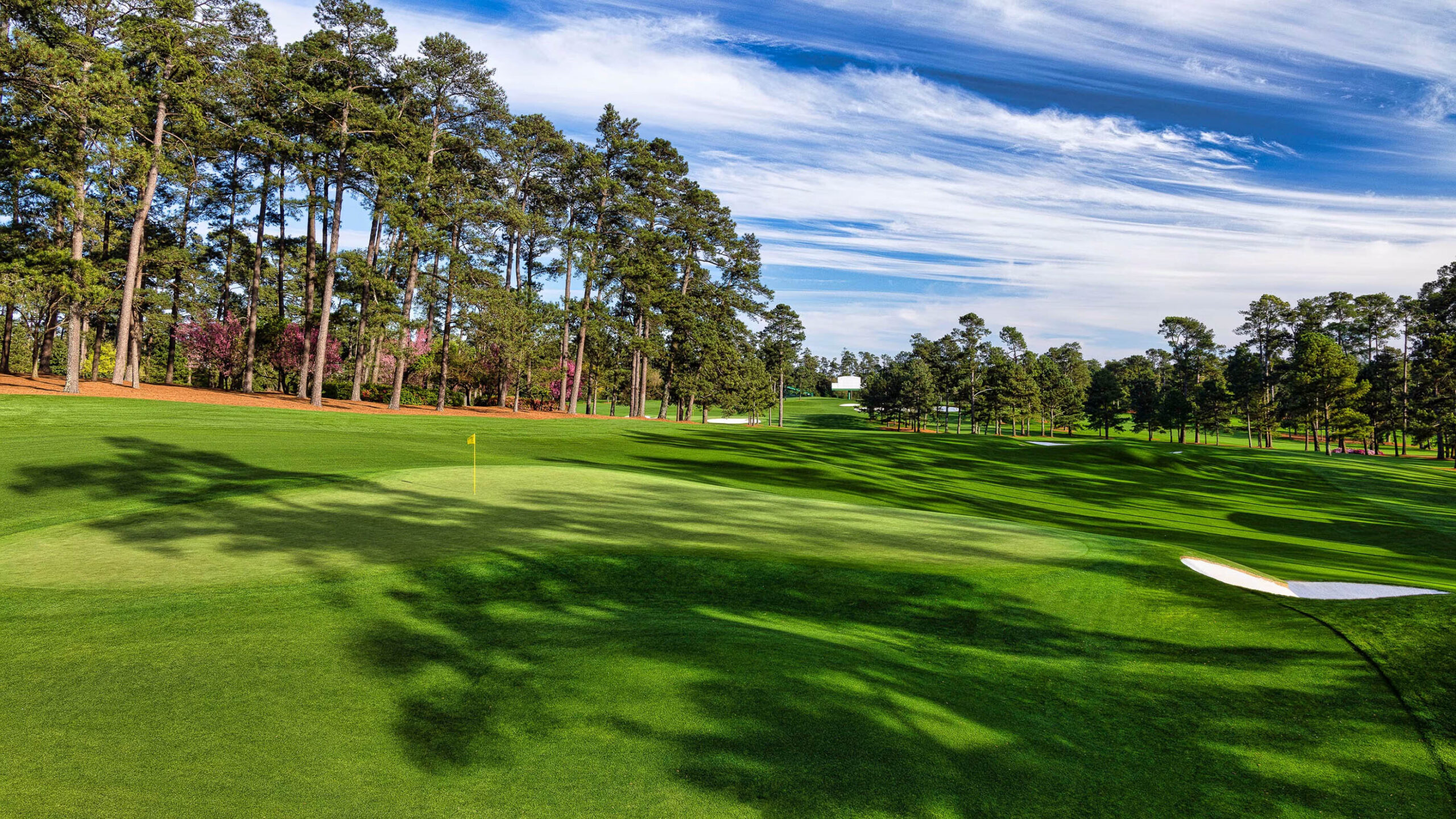
Behind the third green at Augusta National. (Photo: Masters Tournament)
-
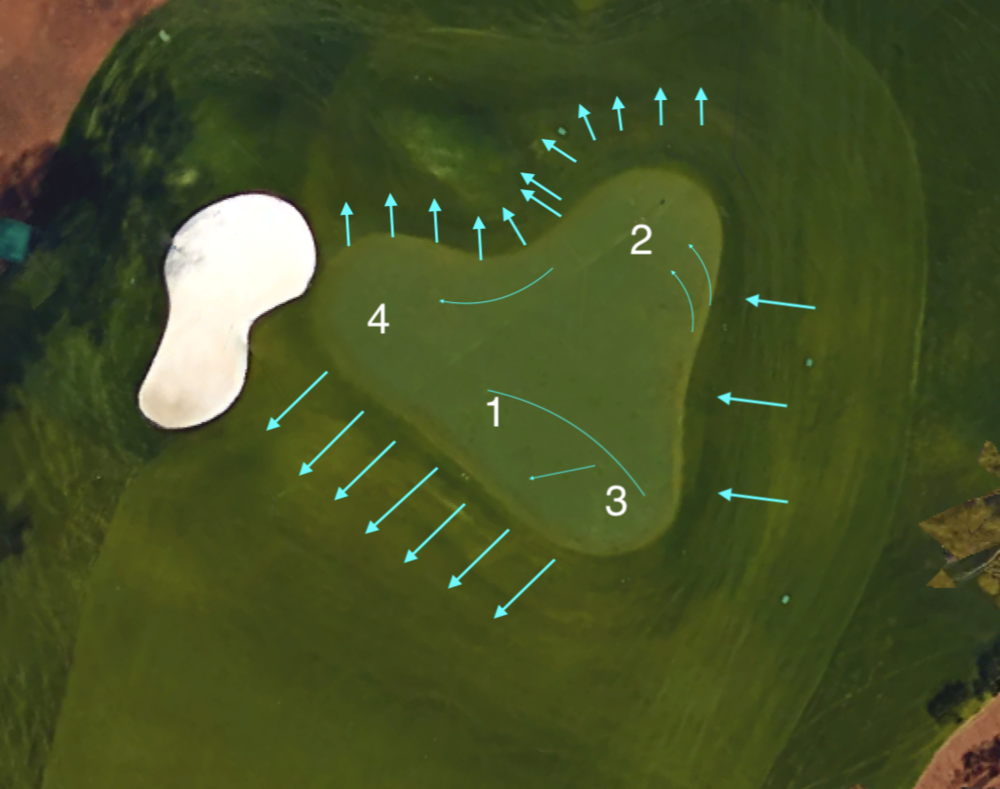
Above the third green at Augusta National. (Photo: Fried Egg Golf)
You can:
1. Hit it short and just left of the bunkers, which will leave you about 130 yards in.
2. Hit it to the most narrow part of the fairway – which isn’t too narrow – but in between the bunkers and the trees on the right, to leave yourself 100 yards or so in.
3. Send driver up there and get within 30 to 60 yards of the green.
If the pin is front right, you can do it from 30 to 60 yards, but it takes a heck of a golf shot to get it really close. But if you lay back at 130, I haven’t seen very many wedge shots from there that land on the front right part of that green and actually stay there. They all bounce and then you’re in the middle of the green, and you have a 30-foot putt with a ton of break. How do you attack that?
If the pin is in the back right, everyone is going to send driver up there because then you can just land the pitch in the middle of the green and it chases back to the hole.
And then I’m still trying to figure out that front left pin. I’ve laid back, but the green is like 13 yards deep on that left side. Plus, usually the greens are firm and that green runs a little bit away from you right where the ball lands. So from 130 yards, when it lands, it bounces over the green. And then from 100 yards, the ball hits and skips hard left and still has a chance of going over the green or it can spin back and come up short. And then from 30 to 50 yards? No chance. From there, you have to bump it into the hill because if you fly it onto the green, you know it’s going to just go over.
So No. 3, with its yardage and the width of the fairway, if you’ve never played it before, you’re thinking it must be the easiest hole on the golf course on paper. But it makes you think so much based on the green complex and how the angles play.
You’ll see so many different options on the hole and you’ll see so many different scores. And I love that in a hole when it’s not just grabbing a driver, sending it, and whacking an iron shot on the green. Making golf courses longer can make them challenging, but the third hole, for example, shows that a hole doesn’t have to be long to be hard.
A popular exercise: Can you rank your five favorite holes at Augusta? Five might be hard so even just your favorite?
It’s hard not to say 12 as one of my favorite holes. It’s so frustrating because it’s such a short par 3, yet you can make a mess of it. If you went to the range and told a Tour player: “Here’s a bucket of balls, there’s a green out there, you have a 145-yard wedge shot.” They’re never going to miss the green.
But you get to the 12th tee, you have water short, and long is no fun either. You’re standing there on the tee box and the clouds are going one way, the flag on the green is going a different way, and the wind you wrote down in your yardage book is different than those two. Plus, the flag on No. 11 is blowing a different direction and you’re sitting there like, what does this do? What are we doing? And that’s a shot that you have to fully commit to. When you hit a shot there, you’re just holding your breath. Then once it lands on the green, you’re able to exhale.
I would say that’s one of my favorite holes – if not my favorite – on that golf course.
Are there any holes you feel are underappreciated? People tend to think of – let’s say Nos. 11, 12, 13, and 15. Excluding those, are there any holes you think just don’t get enough credit for how brilliant the design is?
I think No. 8, the par 5. The tee shot is pretty benign, but if the wind is off the left and you end up in that bunker on the right, the layup on top of the hill still leaves you 140 yards in. It’s one of those holes where if you hit a quality drive, you’re able to hit 3-wood and have a chance to go for it in two. The way that green is set up, it gives you a chance to make three. But then at the same time – even if you hit two quality golf shots – you have to do your homework around that green and know exactly where you need to leave yourself to each pin placement because the green has a ton of slopes and subtleties in it. And it’s so narrow. It’s fair, but at the same time, it can really beat you up.
-
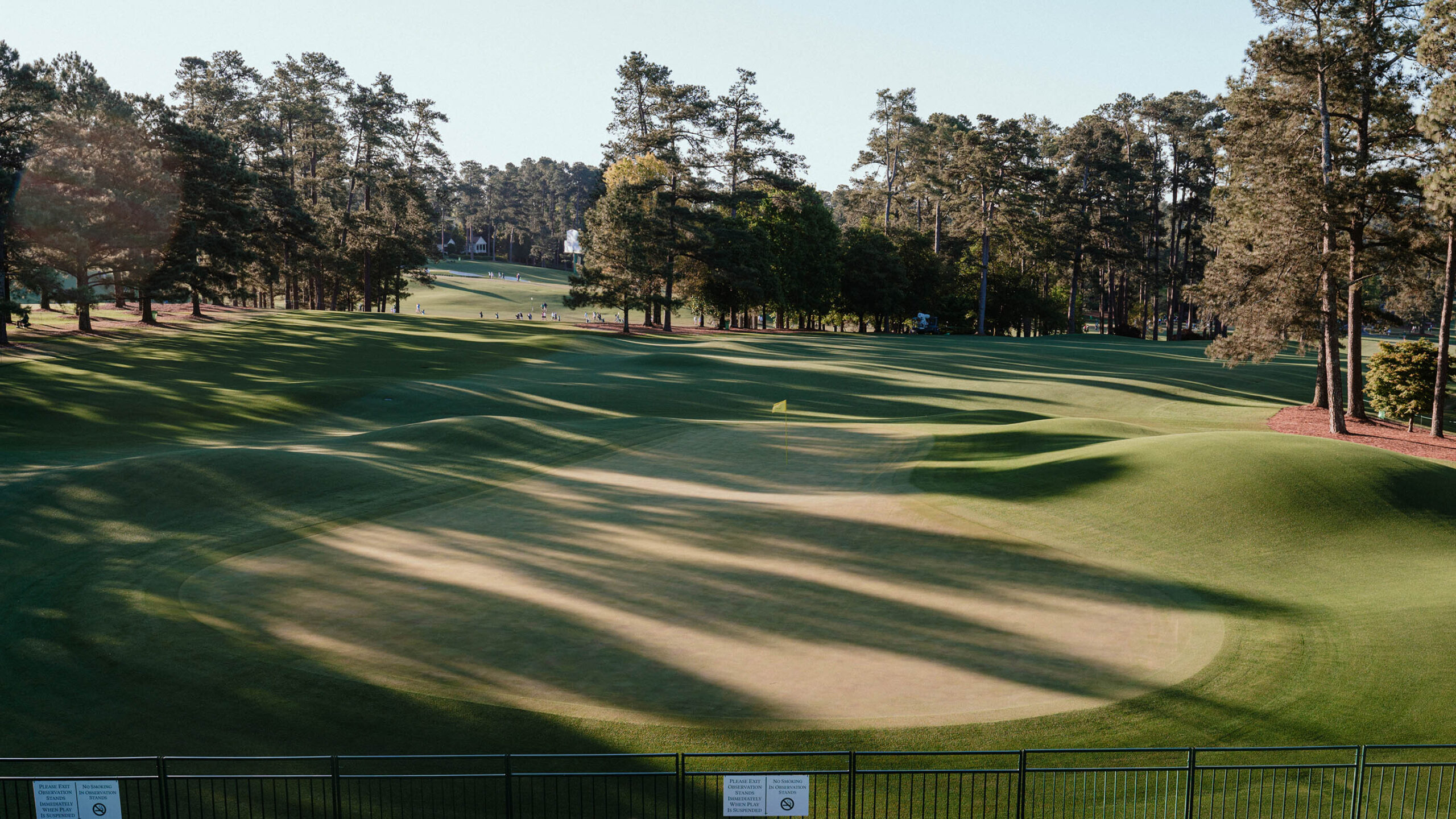
Behind the eighth green at Augusta National. (Photo: Fried Egg Golf)
-

The eighth green at Augusta National. (Photo: Fried Egg Golf)
-
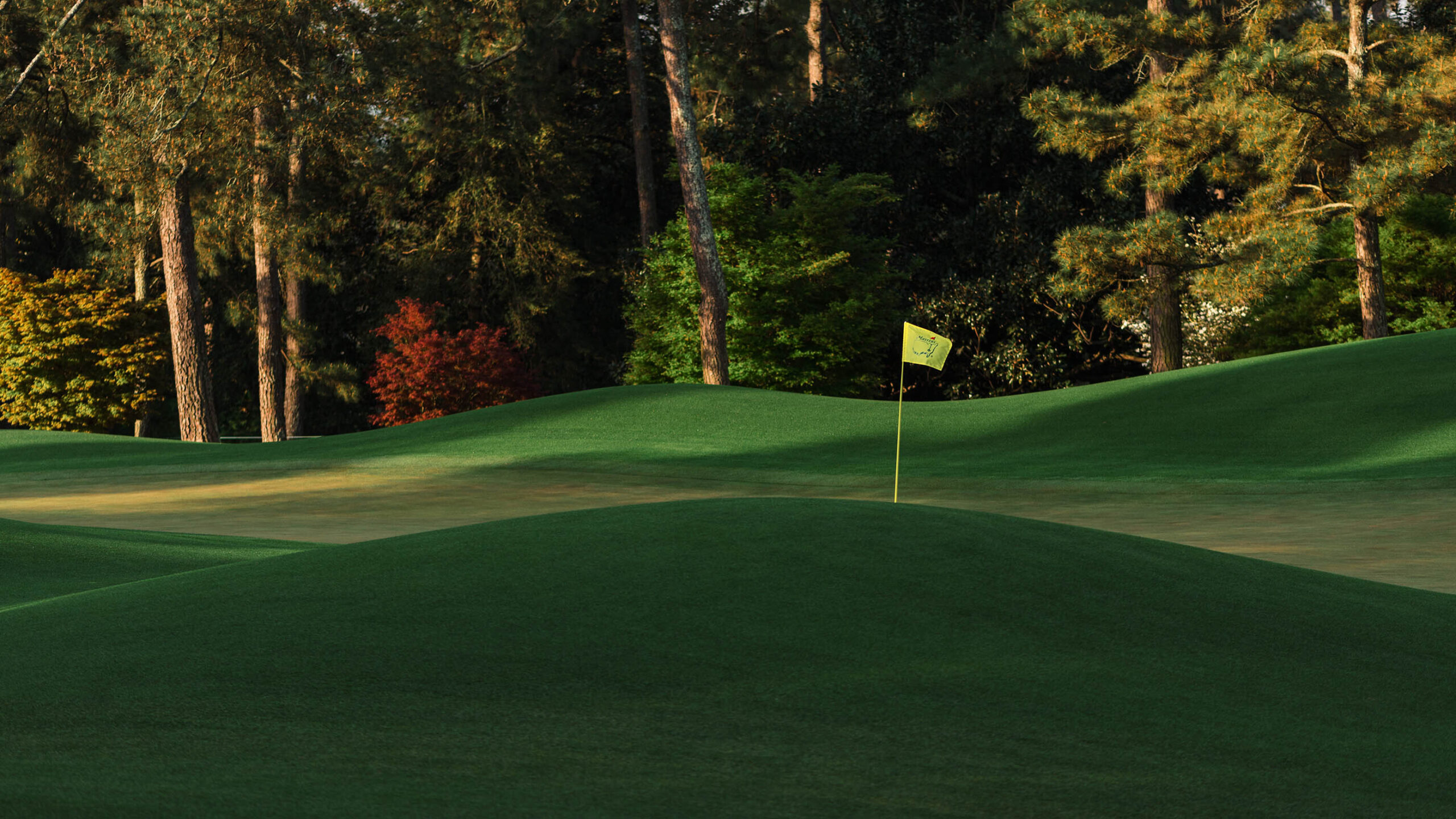
Side view of the eighth at Augusta National. (Photo: Fried Egg Golf)
And then, both Nos. 9 and 18 to close out the nines. I actually was just there last week and nine was downwind. I hammered driver and got down to the bottom on the flat with 110 yards to the flag. But downwind with that green elevated and having three different levels: if you don’t have the perfect ball flight and the right type of spin on the shot you’re hitting, it very easily could skip up the wrong ridge. Or it could grab, spin, and come back almost to your feet. So Nos. 9 and 18, if you hit two quality golf shots you’re really rewarded, but if you misstep on just one of them, you’re sitting there just scratching your head trying to figure it out.
-
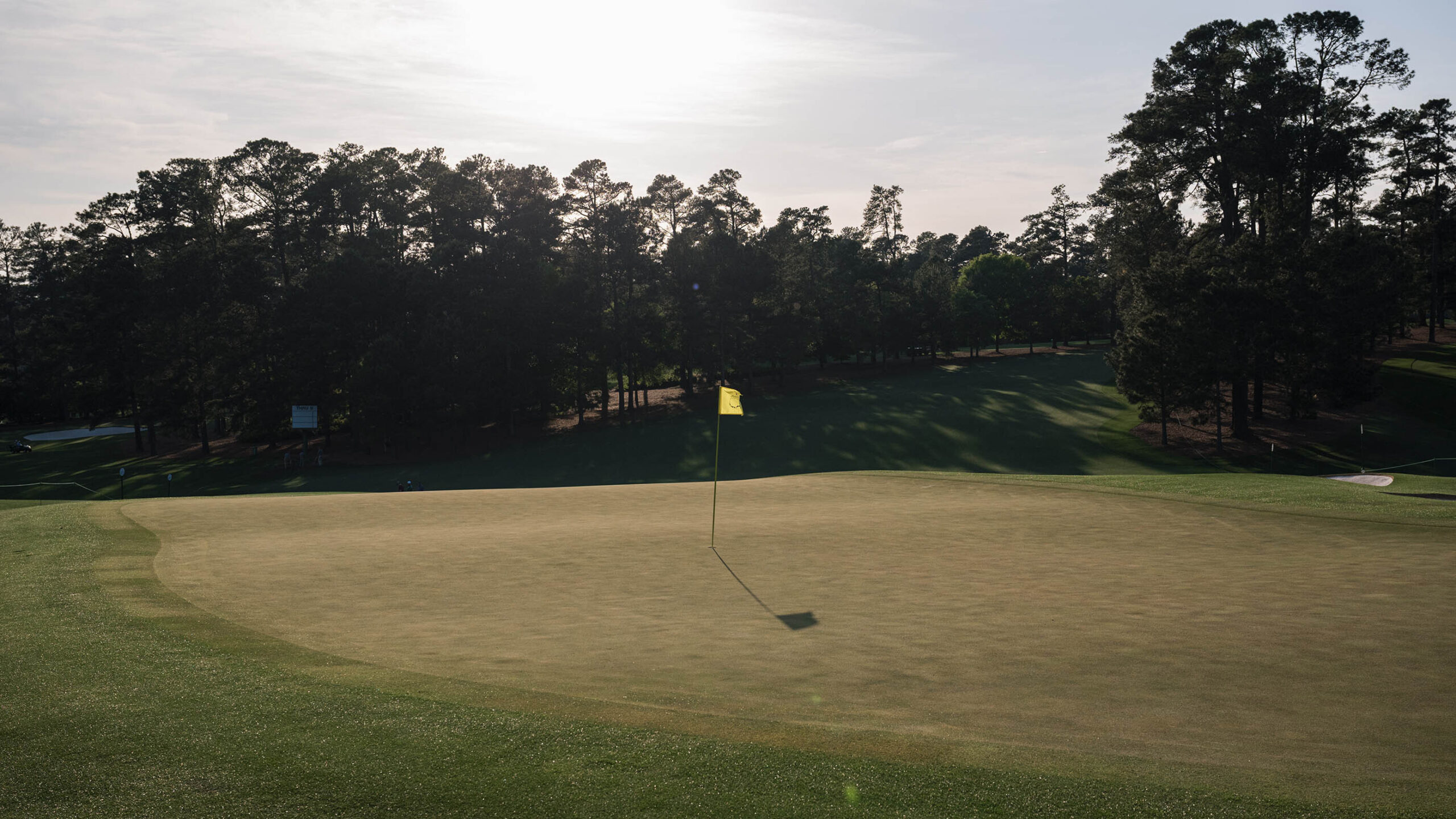
The ninth green at Augusta National. (Photo: Fried Egg Golf)
-
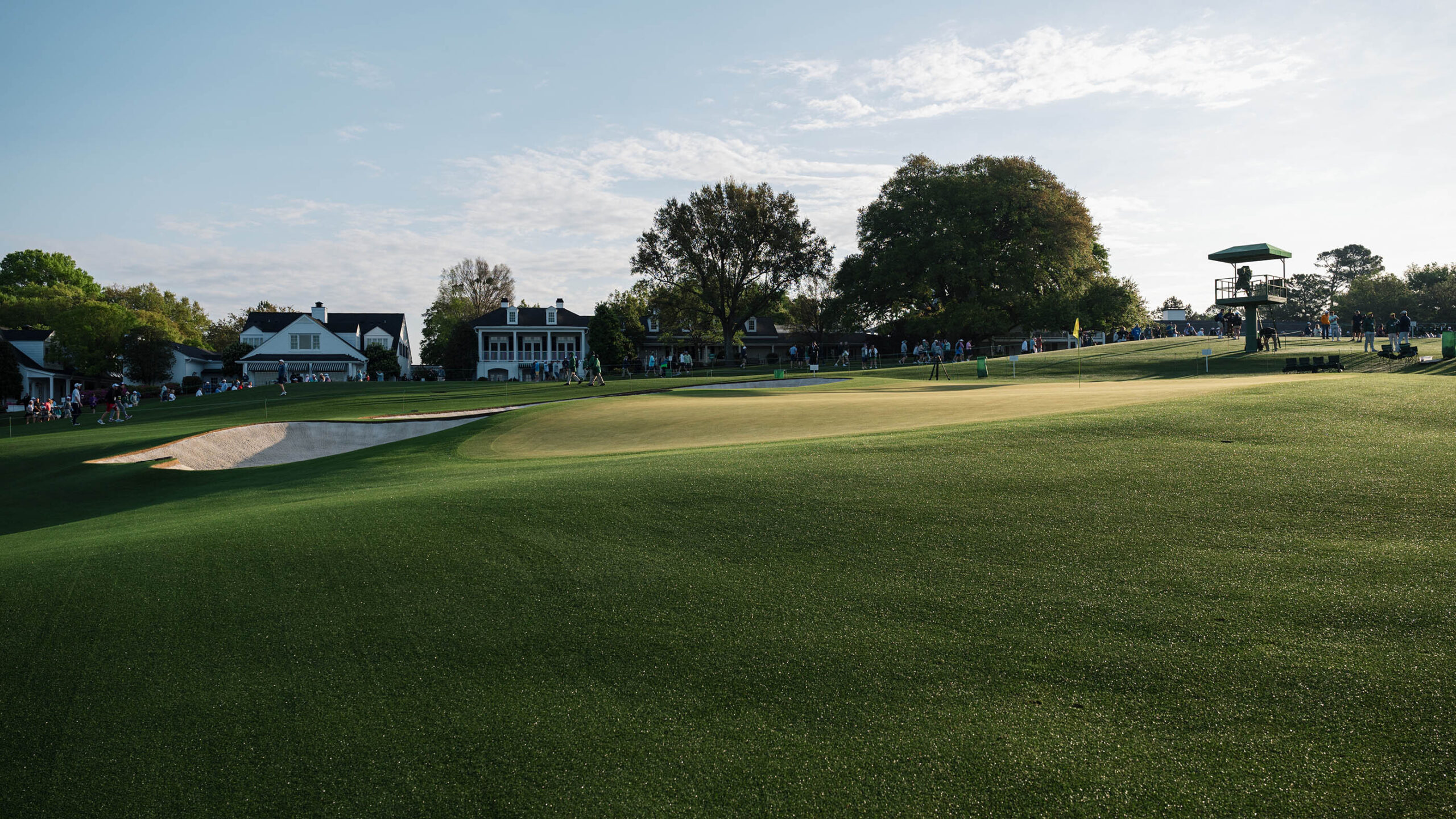
The ninth green at Augusta National. (Photo: Fried Egg Golf)
You’ve had much more success at Augusta in your last seven starts compared to your first four. Four top tens in your last seven starts, including a win, and you made the cut in all seven. I’m curious if there are any specific lessons you learned the first couple of times around that golf course that you’ve applied now in those most recent seven starts or any holes you play differently.
The first one is No. 1: I stopped hitting driver. Every time I tried to hit driver with a draw I’d always hit it in the left trees because it kind of pinches in there. Now I always hit 3-wood off that tee unless it’s into the wind so driver can’t reach the neck where it narrows. That’s allowed my days to start a little easier because you never like to start your round from the trees. Even though 3-wood leaves me longer in, I’m able to hit two golf shots towards the flag.
I would say the biggest thing, though, was kind of letting go. The first four years, I felt like when I got to the first major, even though I was fully prepared, I’d put so much pressure on myself, like “You have to play well – it’s the first major, you have to get going.” And then starting in my fifth year, I was like, “You know what? Let’s go into this differently. I know you’re ready. I know you’ve put in the work, and you’ve got all the prep done. Go play golf, have fun, enjoy yourself, and just take it a shot at a time.”
And not put so much pressure on myself that this is the first tee shot at the Masters or the first major of the year. No, this is just a normal golf shot. And once I learned how to do that and kind of let go and let it come to me, I started playing a lot better. Around that place, it doesn’t matter if you’re hitting a driver, a 5-iron, or just a little wedge, you have to think about every single golf shot. By the end of the week, you’re mentally tired. The last thing you want to do is keep putting pressure on yourself that you have to play well.
Pressing seems to work in other sports. In golf, it’s the total opposite. The harder you press, the more you mess up in golf. You have to relax and let it come to you. That’s when you’re able to freewheel, get more comfortable in your swing, and get more comfortable in the things you’re doing. Clarity goes up and that’s when all of a sudden the low scores start happening.
It took me a little bit to actually buy into that. And it’s definitely worked at Augusta.
I want to revisit your 2018 win. It’s been seven years. Is that day a blur? What do you remember about that Sunday?
I remember just about everything about it. My best memory of that day – and really it’s my best golf memory – was after I won and got my hug from my wife and went to the ceremony and everything. I’m thinking the whole family is back at the house waiting for me. Once I got done with the ceremony and the media, they’re like, “All right, we’re going to Butler Cabin for a little bit.” And then I go to dinner with all the members, and right when I go to grab the door handle, the door opens and it’s my daughter there. And she goes, “Daddy, you did it. I love you.” And that memory, as a father, I just melt. That was the best memory ever at Augusta. Whatever happens on the golf course, nothing will ever top that.
On the golf side, I’ll never forget waking up that Sunday and I was so calm. I didn’t feel anything. I’m watching cartoons with the little ones, just chilling and watching that. And I go to the golf course really calm, have a great warmup, no nerves, feeling at peace, feeling ready to go.
I hit a couple of putts there on that putting green right behind No. 1 tee. Then right when I stepped onto that first tee box, it was like all the oxygen got sucked out. The nerves hit me like crazy. And my brother-in-law – my caddie – goes, “You feel it too?” I said yes and he’s like, “All right, let’s just get off this tee and get going.” He handed me my 3-wood, told me we just couldn’t go right off the tee and we’d figure it out from there. I ended up hitting it left and making bogey.
But then after I got done with No. 1, I was calm the rest of the day and had no nerves. I was just trying to execute every single golf shot and play golf. It was one of those days where I expected to be a lot more jittery and nervous throughout the whole round. And really, I’ve never been so calm and just ready to go play golf.
Are there any shots from that day that you think back on proudly that people on TV probably didn’t realize how hard that shot was?
Under the circumstances, the iron shot I hit on 12 – right down my line. Then the putt was about 30 feet, and it had about five feet of break. The thing that’s so hard about Augusta is – golf shots, yes – but also putts. To hit putts that have that much break and actually match up the perfect speed and watch them go right in the heart. As players, those are the ones you’re the most proud of.
And then, No. 18 always gives me a hard time. Especially back then, I had to do the helicopter swing to hit the cut. So hitting a solid drive there on 18 and then stepping up – in between 8- and 9-iron – and with the ball above my feet and on such a big upslope. When you hit a soft iron shot there, it’s very easy to get it going left. So to be able to hit a soft (8-iron) and flag it, it definitely showed that I knew what I needed to do with my golf swing.
I felt like I didn’t do anything miraculous or spectacular that day with my ball striking. I just hit it where I wanted to go. Nothing flashy. Just pinpointed my way around that place and let the flatstick work.
Rewatching your final round, it felt like you didn’t really get that much out of that round.
Yeah, no, I was just trying to keep it going. Just pinpoint myself around that place and try to play boring golf, right? That’s the biggest thing at Augusta, which is so hard to do. It’s hard to do anywhere. Just play boring golf. If you’re hitting fairways, hitting your lines on your irons and giving yourself a lot of opportunities and rolling in a couple, all of a sudden you look back and it was a really boring 68 or 67. But those are dream rounds.
Really, though, it was eagling both 13 and 15 on Saturday. It started raining and I hit just a beautiful iron shot on 13 that chased up to that back left flag in close. Then on 15, I hit 3-wood in and thought it was going to be plenty to get into the green side bunker. Somehow it came up just short of the bunker in the fairway. And then I go chip that in. To be 4 under on those two holes, that was huge. That chip on 15 was dirty. That was a good one.
Last Augusta question: It’s the golf course that’s the most profiled, most studied. Is there anything that you think flies under the radar that’s underappreciated about it? People have come to know how hilly it is, which you can’t really appreciate on TV. But is there anything else specific that you think more people should understand about that golf course?
Everything is mown into the grain. I’ve played it under normal member play where they don’t mow it straight into the grain. Hitting chip shots and pitches is so easy when it’s not into the grain. But with that grass – how thick it is and lush and how it’s always into the grain – if you don’t hit your pitches and chips perfectly, the ball is not going to react how you want it to.
On top of that, at a lot of golf courses where we play, there’s always a little variance in the greens from hole to hole on firmness and speed. At Augusta, you could find one or two that are either a little firmer or a little softer than others because they’re more exposed. Like 17, for example, is always exposed, so you expect that one to be a little bit more crusty and firm. But overall, they’re all really, really similar. They know how to get everything just dialed to where everything is almost the same. And it’s very hard to do, but they have that recipe. Augusta knows how to get it done.
I want to talk about your short game. I believe you’re the best around-the-green player in the world. How did your short game get to an elite level?
Growing up, I never hit fairways, so I was always having to get up and down from everywhere as a kid. And when I was growing up, I was watching Tiger and Phil obviously in their heyday. Everyone always wanted to be like Tiger with his success in golf and his demeanor and how he got his way around the golf course. You could just see the drive and the motivation in his eyes and the way he played. But I also loved watching Phil and his short game – flop shots, chipping lobbies, doing all that stuff.
Growing up in San Antonio, I belonged to the Dominion Country Club, which had a chipping green that was two-tiered – it had a bunker and had fairway everywhere. I was always over there chipping and just fell in love with it.
I was always pretty good at it, but then I made a whole extra step and got elite at it when I started working with Dave Pelz back in 2014. And Dave, he made it so simple. Not only just short game but the thought process going into each shot and with drills and games.
When you’re sitting up there just putting or chipping, it gets boring doing the same shot over and over again. Dave knew how to bring the best out of everyone, not just technique but with fun games to keep you engaged. I still do all of them and always will. It just allows me to see the creative side and attack short game with more creativity and thought rather than just setting up and trying to chip it within a three-foot circle.
There’s some debate in the golf world when you’re chipping as to the extent to which you should just try to chip the ball as close to the hole as possible versus prioritizing leaving a putt that’s below the hole. I’m curious for your perspective on that, especially somewhere like Augusta National.
At Augusta, you want to leave it below the hole. Above the hole is not fun. A five-footer above the hole is probably equivalent to a nine-footer below the hole at Augusta. You’re always trying to leave yourself the uphill putt – the one you can be kind of aggressive with.
I always go into every chip reading it like a putt and trying to make everything. Everyone is always trying to chip it within a three-foot circle. Well if you miss your three-foot circle, now you’re four or five feet away. If I’m trying to make the chip and miss, it’s going to be within the three-foot circle. So I always see the chip and how it’s going to roll once it’s on the green and where it needs to enter the hole. And that allows me to know exactly what kind of shot I need to hit and where I need to land it.
It’s like Adam Vinatieri, the field goal kicker, always would say, “Aim small, miss small.” Well, same kind of thing in golf.
Last short-game question: When you play with a double-digit handicapper, are there any common things you wish you could tell them about their short-game technique that could help them improve?
Oh, for sure. On putting: speed.
There are so many 10 to 15 handicappers I play with that have three or four three-putts in a round. And we’re not talking about a three-putt from 100 feet. We’re talking a three-putt from 25-30 feet. And it’s all because of the speed on their first putt. You may not have the right line, but if you have the correct speed, you’re not going to misread the putt by three feet. Just work on knowing speed, how to read the grain and how much slower it’s going to be into the grain. Then uphill versus downhill. If you have good speed control, your handicap will improve so much.
And then on the chipping side, you have to get the ball on the green. The number of times I see people either hit a chip or a bunker shot and then have to hit a chip or a bunker shot again – it’s basically a penalty shot. It’s a wasted shot.
Modern drivers have trended towards being more fade-biased; not that many guys on Tour hit a draw anymore. As a player whose natural shot shape is a draw, how have you had to adapt your game to the evolving driver technology?
Drivers, they’ve just gotten faster, bigger and made for less spin. To get a ball to go farther, you need it to launch high, and you need lower spin. If you hit a draw with low spin, it kind of falls out of the sky. To keep the ball in the air, they’ve gone to those left-to-right knuckle fades that a lot of guys hit. I’ve had to go try to find smaller heads because then you don’t have the drag from the toe, so then the club will actually close over a little bit and it’s easier to hit a draw. If you want to be a player who hits draws, I think you need a smaller head because when it’s a little smaller, it’s easier to turn over. I’ve tried moving around weight with hot melt and stuff inside the head, putting more weight towards the heel, etc. But I can feel the weight in the heel, so then I start hitting everything out of the heel because I actually start finding the weight.
Technology has evolved to try to get everybody to hit it farther, hit it straighter, hit it longer. Drivers just keep getting bigger. The sweet spot is getting bigger. It kind of takes away some of the creativity that you can have with drivers and with shot-making off the tee.
A lot of that has to do with drivers, but a lot of it also has to do with the golf ball. Golf balls just don’t curve that much anymore. They go up, but they don’t curve as much, so now mishits kind of stay in play. Unfortunately, I wasn’t on Tour yet, but I think about how back in the day the professionals used tour balatas and how much those balls would spin and go offline. That’s a shot maker’s dream. You can hit the flat draws, the flat cuts, the softies, the high spinners, etc. You could actually see shots and be more creative, but technology these days is all about hitting it farther, hitting it straighter, and having more control. And the easiest way to do that is by not allowing the ball to spin as much sideways and not have as much backspin.
So for a drawer, you want smaller heads so that the toe is not dragging. You can go a little bit more upright. The only thing I worry about is the more upright you go, the more the ball is going to start left. I’d actually almost go the other way. I’d go a little flatter so you can feel like you really release the head and go ahead and let it go.
A big topic that you’re touching on there: Are you in support of an equipment rollback, either bifurcation or across the board? And do you think it’d be most effective to regulate the driver head, the golf ball, or both?
Ooh, some people are going to hate me for this one. Personally, I don’t know what they’re going to do because they haven’t really said how they’re going to draw these back, right? But I think you go back to the lower compression, back playing the balata for professionals where, if you mishit one of those, they would spin so much and they’d start going sideways. And then with the driver heads: make them smaller. Make them back to almost like they were back when metal woods first came out. Make them tiny, make them small heads. Then it puts a premium on hitting the ball in the middle. If you can swing it 130 miles an hour or however fast these guys can swing it, and have ball speeds however fast they are, more power to you. But you better hit it in the screws and have control of that face.
We’re the top 1% in golf – the guys out here on tour. It shouldn’t matter if we’re using the dinner plates as drivers nowadays that you can hit anywhere on the face and hit it straight. We should be able to hit the small ones. We should be able to have the control and have the finesse to be able to do things like that, to hit different shots. I can still hit my persimmon driver. I have some that I’ve practiced with for technique purposes to make sure I hit the ball solid and square. If I hit that with my normal golf ball, it still goes 275 yards. My (modern) driver, I hit 305 yards? So 30 yards.
My swing speed with the smaller head is going to be a little slower than it is with the big one because with my normal driver, I know I can swing hard. And if I barely miss the center, it’s fine. But with that persimmon head, you have to swing within yourself, you have to hit it solid.
I have no problem with them rolling it back. I just want to know how they’re going to do it. If you’re going to keep these drivers at 460 CCs where the sweet spot is almost the entire head, guys are just going to keep swinging harder and harder. And I’d rather shrink it, make us be the athletes that we are, make us be that top percent that we’ve put all of our grind into and let us show off. Those shots Tiger and those guys were hitting with the small heads and the stingers and what they were able to do with the balls back then, it’s almost impossible to do that stuff now. The golf ball will not allow it. Allow us to show off and do things like that. That is what’s cool to me.
You look at every other major sport, the rules at every other level are different than at the professional level. So roll it back for us, do what you need to do. Make it hard for us, make the smaller heads, make the ball really spinny and kind of go different ways. Make us be creative. That doesn’t mean that you have to do that for everybody. I have no problem with having us play this type of equipment and the amateurs using the equipment they use these days. No problem whatsoever. It doesn’t have to be the same across the board.
This conversation was slightly edited for length.


 by
by 
